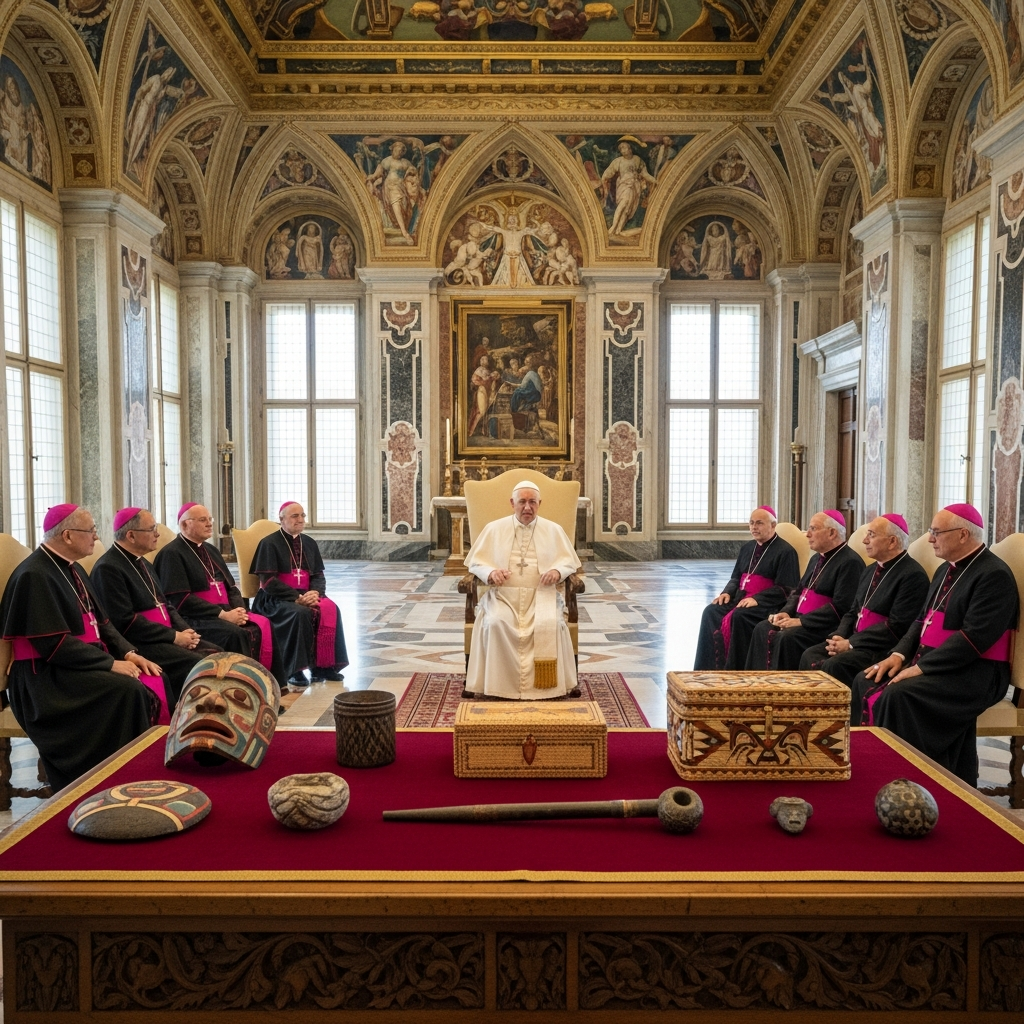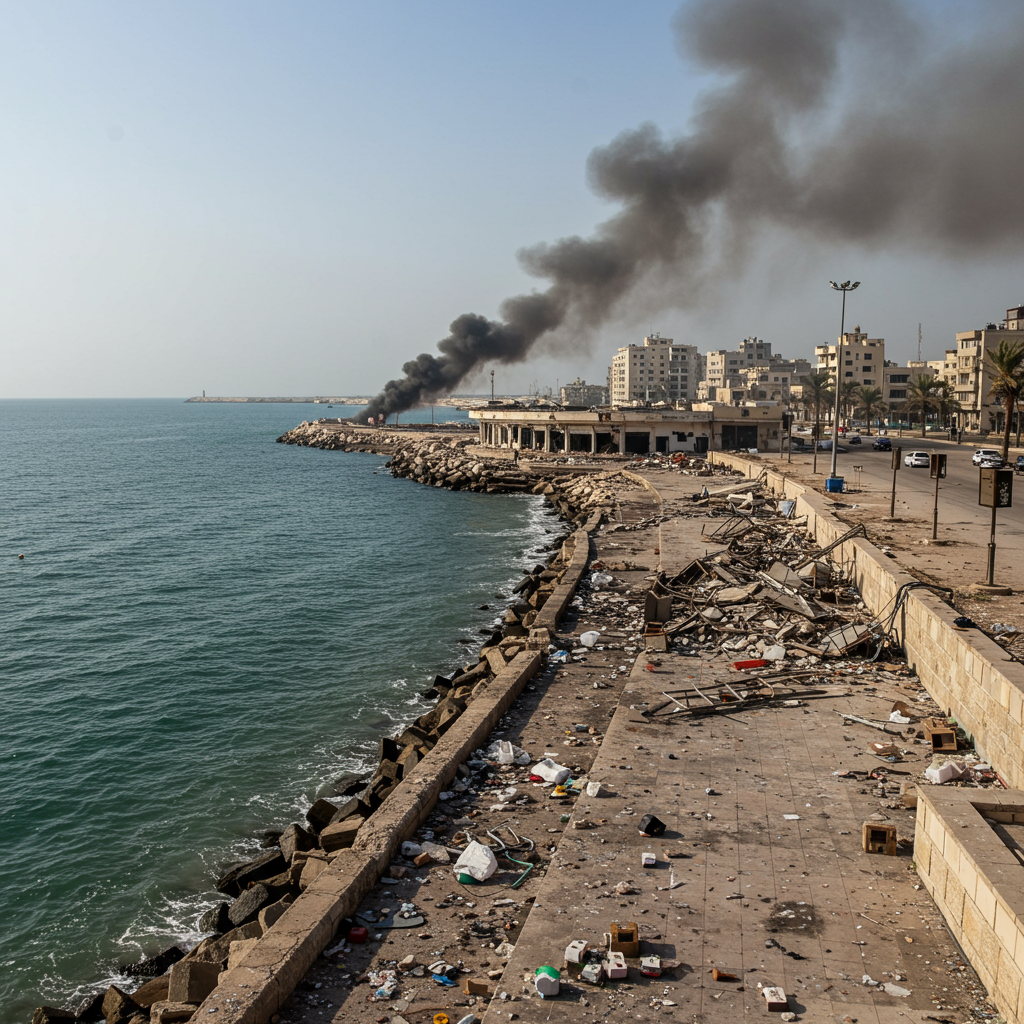In a profoundly symbolic gesture of reconciliation, Pope Leo XIV has overseen the historic return of 62 Indigenous artifacts to Canadian Catholic Bishops. This landmark event, occurring on November 15, 2025, marks a pivotal moment in the ongoing dialogue between the Catholic Church and Indigenous communities in Canada. The artifacts, which had been held in the Vatican Museums for nearly a century, represent a tangible step towards healing and mutual respect. This repatriation directly follows commitments made by the late Pope Francis and underscores a renewed dedication to addressing historical injustices.
The carefully chosen collection includes significant cultural items such as an iconic Inuit kayak, masks, moccasins, etchings, wampum belts, and war clubs. These invaluable pieces, originating from diverse First Nations, Inuit, and Métis communities across Canada, now embark on a journey home. Their return is not merely a transfer of objects; it’s an acknowledgment of cultural heritage and a renewed promise of fraternity, crucial during the Jubilee Year of Hope 2025.
A Legacy Reclaimed: The Journey Home for Sacred Items
The formal handover took place in the Apostolic Palace during an audience with Pope Leo XIV. Receiving the Indigenous artifacts repatriation on behalf of the Canadian Conference of Catholic Bishops (CCCB) were Bishop Pierre Goudreault, President of the CCCB; Archbishop Richard Smith of Vancouver; and Fr. Jean Vézina, General Secretary of the CCCB. This gathering highlighted the collaborative spirit driving this momentous occasion. Vatican officials described the act as “ecclesial sharing,” where the Successor of Peter entrusts these items to the Church in Canada. They bear witness to the complex history of interaction between Christian faith and the rich cultures of Indigenous peoples.
These 62 artifacts were initially sent to Rome by Catholic missionaries between 1923 and 1925. They became part of the Vatican Missionary Exhibition of 1925, an initiative by Pope Pius XI during that Holy Year to showcase global faith and cultural richness. Subsequently, these items were integrated into the Lateran Ethnologic Missionary Museum, which later evolved into the Anima Mundi Ethnological Museum of the Vatican Museums. For decades, Indigenous communities have tirelessly advocated for the return of these cultural treasures. Their persistent calls gained significant momentum during meetings with Pope Francis in 2022.
Historical Context: From Exhibition to Repatriation
The narrative surrounding the acquisition of these artifacts is deeply rooted in colonial history. While the Vatican historically maintained these were “gifts” to Pope Pius XI, many historians and Indigenous groups questioned the voluntariness of such transfers. Significant power imbalances characterized Catholic missions of the era. During this period, Catholic religious orders actively participated in enforcing Canada’s forced assimilation policy. This policy aimed to eradicate Indigenous traditions and has been labeled “cultural genocide” by Canada’s Truth and Reconciliation Commission. The confiscation of items used in Indigenous spiritual and traditional rituals, like those banned by the 1885 potlatch prohibition, often led to their dispersal into museums and private collections worldwide.
Pope Leo XIV’s decision builds upon a path laid by his predecessor, Pope Francis. In July 2022, Pope Francis made a historic Apostolic Journey to Canada, expressing profound shame and regret for the Church’s role in the residential school system. He emphasized the need for reconciliation and to “start afresh.” Further bolstering this commitment, the Vatican’s Dicastery for Culture and Education and the Dicastery for Promoting Integral Human Development published a Declaration on the Doctrine of Discovery in 2023. This declaration explicitly repudiated the 15th-century “papal bulls” used to legitimize colonial land seizures, stating the “Doctrine of Discovery” is not, and has never been, part of Catholic teaching.
The Path to Healing: A Promise Fulfilled
This Vatican Indigenous artifacts return represents a concrete culmination of these preceding efforts. It fulfills a promise made by Pope Francis, who famously cited the Seventh Commandment: “If you have stolen something, you must give it back.” The repatriation is particularly timely, coinciding with the centenary of the 1925 exhibition and the Jubilee of 2025, which embraces the theme of hope. Each artifact is accompanied by comprehensive documentation from the Vatican Museums, certifying its origins and the circumstances of its journey to Rome.
Upon receiving the artifacts, the Canadian Bishops reaffirmed their commitment to their proper safeguarding, respect, and preservation. This will be done in authentic cooperation and dialogue with the Directorate of Cultural Heritage of Vatican City State. However, their ultimate destination is not solely with the Bishops. The artifacts will first be transported to the Canadian Museum of History in Gatineau, Quebec. There, museum curators will work with Indigenous communities, experts, and elders to examine, catalog, and identify their specific provenance. This collaborative process ensures that the items are eventually reunited with their rightful communities of origin across Canada.
Canadian Ambassador to the Holy See, Joyce Napier, underscored the historical importance of the event. She called it “historic” and “a significant step towards reconciliation.” This action, therefore, transcends a simple handover. It is a powerful affirmation of Indigenous rights, a tangible effort to restore cultural integrity, and a testament to the ongoing journey of Catholic Church reconciliation with the Indigenous peoples of Canada.
Frequently Asked Questions
What is the historical context behind the Vatican’s return of Indigenous artifacts?
The return of these 62 Indigenous artifacts is a direct response to decades of advocacy from Canadian Indigenous communities. Historically, these items were sent to Rome by Catholic missionaries between 1923-1925 for the Vatican Missionary Exhibition of 1925. While presented as gifts, their acquisition occurred during a period of significant power imbalance and colonial policies, including Canada’s forced assimilation policy, which suppressed Indigenous cultures. The repatriation builds on Pope Francis’s 2022 apology for the Church’s role in residential schools and the 2023 repudiation of the “Doctrine of Discovery.”
Where will the returned Indigenous artifacts be housed initially in Canada?
Following their formal transfer from the Vatican, the 62 Indigenous artifacts will be transported to the Canadian Museum of History in Gatineau, Quebec. Here, museum curators, in close collaboration with Indigenous communities, experts, and elders, will undertake the crucial work of examining, cataloging, and identifying the specific provenance of each item. This initial phase ensures proper care and documentation before the artifacts are eventually reunited with their respective First Nations, Inuit, and Métis communities of origin across Canada.
How does this artifact repatriation contribute to ongoing reconciliation efforts?
The Vatican Indigenous artifacts return is a concrete and highly visible step in the ongoing reconciliation efforts between the Catholic Church and Indigenous peoples in Canada. It represents a tangible acknowledgment of past wrongs, a commitment to restoring cultural integrity, and a move away from colonial legacies. By returning these cultural treasures, the Church demonstrates respect for Indigenous heritage and supports their right to self-determination over their patrimony. This act fosters deeper dialogue, builds trust, and helps to heal historical trauma, aligning with the spirit of the Jubilee Year of Hope 2025.
Continuing the Journey of Respect and Dialogue
The Vatican Indigenous artifacts return is more than an exchange of historical items. It symbolizes a profound commitment to reconciliation, dialogue, and respect for Indigenous cultures. As these 62 artifacts journey from the Vatican to Canadian soil and eventually back to their ancestral communities, they carry with them the weight of history and the promise of a more equitable future. This act stands as a powerful example of the transformative potential of confronting the past, fostering healing, and building bridges of understanding. It reinforces the importance of cultural heritage in identity and the ongoing imperative for institutions to reckon with their colonial legacies.




